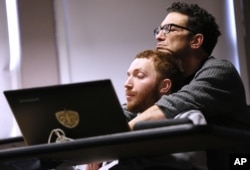The human body has about 25,000 genes. Researchers already know of 65 genes they believe carry a risk for autism. Now, researchers at Princeton University in New Jersey have identified 2,500 more that could help create the conditions for autism.
The discovery is important because the genes could lead scientists toward finding a cause and, possibly, a treatment.
Autism and … Facebook?
Autism is a condition that makes it difficult for some people to communicate, learn and socialize.
Arjun Krishnan is a researcher at Princeton’s Lewis-Sigler Institute for Integrative Genomics. He says researchers used what they called a machine-learning computer program to identify autism-related genes.
Krishnan explains that the program identified similarities between brain-related genes and the 65 autism-risk genes.
Then, the program looked for other genes that are “friends” of both sets.
He says the process is like finding friends on Facebook.
"And if Facebook wanted to find out who your friends are and wanted to suggest a friend for you, what they would do is find out who your friends are and then find out other people who are friends with those same people. And if they are, they are very likely friends of you, too. So that is how they give you suggestions of new friends you might know. We used a very, very similar strategy..."
The strategy permitted researchers to find patterns within the brain’s huge circuitry. It showed that having genes that are “friends” of both brain-related and autism-related genes can increase a person’s risk for autism.
The findings can also help researchers understand why one person may be only mildly affected with autism, while another is severely affected.
Olga Troyanskaya is a professor of computer science and genomics at Princeton. She says people’s entire sets of genes influence what kinds of symptoms they have.
In other words, autism researchers need to consider not only individual genes, but also gene combinations.
Researchers still have not found a way to diagnose autism, beyond just observing the child. But they hope this new research into gene patterns will lead to a way to diagnose very young children. Then they can be helped as soon as possible.
I’m Anne Ball.
Jessica Berman reported this story for VOA. Anne Ball adapted it for Learning English. Kelly Jean Kelly was the editor.
We want to hear from you. Write to us in the Comments Section and visit us on our Facebook page.
_______________________________________________________________
Words in This Story
autism – n. a condition or disorder that begins in childhood and that causes problems in forming relationships and in communicating with other people
circuitry – n. a system or group of circuits—or paths
diagnose – v. to recognize a disease by examination
entire - adj. compete; not lacking any part









